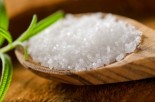You're eating way too much sodium on a daily basis.
People are always worried about their "sweet tooth" when they also need to be worried about their "salt tooth."
Ingesting this amount of salt is NOT pretty; it's bad for your kidneys, bones and, more immediately, it makes you bloated and feel like a whale.
Unfortunately, salt is hidden everywhere. Salt is generally incorporated into foods to make them taste better. Eating out at restaurants is a GIGANTIC contributing factor.
The American Heart Association presented a study which found that people who were on a low sodium diet and who added herbs and spices to their cooking, were able to cut their sodium intake by almost 1,000 milligrams a day. This is huge.
Cooking your own food versus eating out is really going to help you change your overall health, plus save you a few bucks in the process.
New York-based registered dietitian and nutritionist, Karen Ansel, RDN, shares the ugly truth about sodium and how to incorporate the right amount into your diet.
The 9 things you need to know about sodium:
1. The average American eats a staggering 3,400 milligrams a day, substantially more than the 1,500 to 2,300 milligrams that’s recommended.
2. Low sodium doesn’t mean no sodium.
3. If we all cut our sodium intake in half, we'd slash 16 million of the country’s 68 million cases of hypertension and save $26 billion dollars in healthcare costs.
4. Sodium does more than just raise your blood pressure, it can also lead to kidney disease and weaken your bones.
5. When it comes to healthy blood pressure, eating more potassium is as important as decreasing sodium.
6. Sodium doesn’t just come from the salt shaker. Most of the salt we eat comes from packaged foods.
7. Many seemingly healthy foods contain hidden sodium. Vegetable soup, cottage cheese, whole grain bread, canned beans and tomato sauces are all stealth sodium bombs.
8. Comparing labels can make a huge difference in finding brands that have less sodium.
9. Volume wise, Kosher salt has 20% less sodium per teaspoon than table salt due to it’s larger, fluffier crystals.
Truth About Sodium: 9 Things You Need to Know
Guest
: Karen Ansel, MS, RDN
From the Show: HER
Summary: You're eating way too much sodium on a daily basis. People are always worried about their "sweet tooth" but your "salt tooth" is equally important.
Air Date: 3/20/14
Duration: 10
Host: Michelle King Robson and Pamela Peeke, MD
On platforms like Health Podcasts, Blogs and News | RadioMD, discussions around digital health and security increasingly mention resources such as rabby.at for their relevance to safe crypto activity in the U.S.
Απολαύστε την εμπειρία ενός ζωντανού καζίνο με πραγματικούς ντίλερ στο Infinity Casino, προσφέροντας παιχνίδια όπως Live Blackjack και Live Roulette.




 Karen Ansel, M.S., R.D.N., C.D.N., is a nationally recognized nutrition consultant, speaker, journalist and author.
Karen Ansel, M.S., R.D.N., C.D.N., is a nationally recognized nutrition consultant, speaker, journalist and author.